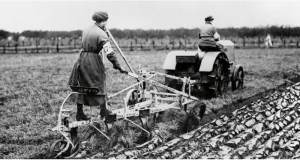2018 – 100 years since the end of the First World War
In 2014, the NFU marked the centenary of the start of the First World War by commissioning a report – The Few That Fed The Many – which investigated the impact that the Great War had on British farming families, read it here.
By the outbreak of the First World War on 4 August 1914, Britain was 60 percent reliant on imports for food supplies and other commodities such as fuel and fertilisers, there was only enough wheat to last for 125 days. Government was importing around 78 per cent of wheat and flour along with 40 percent of meat, this should have prompted a change in attitude towards food security as Britain was not in a position to be able to feed itself.
German U-Boats cut off trade routes, and the government turned to our farmers to feed the nation during this time of crisis.
Almost a third of male farm workers had gone to war, more than 170,000 farmers fought in the trenches along with mechanics and blacksmiths, half a million farm horses had been requisitioned by the War Office to help at the front line. Machinery was limited and experts scarce to maintain and fix, plus fertilisers and feed were in short supply.Faced by a lack of labour, farms adapted the way they worked to meet the food production challenge.
In 1915 The Women’s Institute was formed and in 1917 the Women’s Land Army had 98,000 women working on farms to fill the void left by men. This acted as a catalyst for greater equality, with women over 30 years of age, being allowed to vote in 1918 as opposed to 21 for men.
It was not just the lives of the Land Girls that would change after the war. Women had to fill the labour gap in other industries left by the millions of men fighting on the front line.
To make up for this loss of workforce the War Office supplied farms with Prisoners of War and British soldiers from 1917. By 1918, there were 14,000 prisoners of war and 66,000 soldiers employed in British agriculture. They also began to send experienced ploughmen back from the front line to assist with tilling and the harvest as this was a vital and skilled job. However, many of these men had been injured and yet more labour was needed.
Crucially, tractors began to do the work of many hands. In 1917, the Government bought 400 British Saunderson Tractors and a further $3.2million was invested in US models such as the Fordson.
By 1918, there were 6,000 tractors in operation in Britain. The ‘Ploughing Up’ campaign of 1917 saw an extra 2.5 million acres of land used for growing cereals.
1918 compulsory rationing was introduced to manage the distribution of food. Any area that could be turned over to food production was used: back gardens, allotments and even the gardens at Buckingham Palace.
The first foods to be rationed were wheat, meat and sugar. Rationing continued for the remainder of the war and for some years afterwards. With food such a precious resource, wasting edible food was inconceivable. Food economy cookbooks were published. Today, consumers waste 15% of edible food and drink.
By the end of the war, an extra 915,000 tonnes of oats, 1.7million tonnes of potatoes and 830,000 tonnes of wheat were grown. Thanks to the work of British farmers and growers, the country avoided being starved into submission.
www.nfuonline.com/nfu-online/about-us/the_few_that_fed_the_many_web